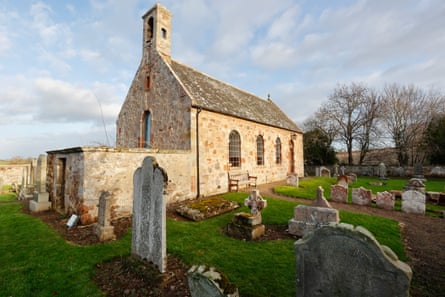At first sight the lichen-covered sandstone slab seems to be a doorstep for Morham church in East Lothian. Yet four rusting iron rings set into the stone hint at the slab’s true purpose.
Once the slab is lifted by those four iron rings, stairs lead down into a crypt which hold the remains of some pivotal figures in Scottish history. Their presence is delaying the sale of the church overhead, in a controversy that raises significant questions about the ramifications of one of the biggest property selloffs of modern times.
The Church of Scotland, once one of the most powerful forces in Scottish life, is disposing of hundreds of churches, manses, halls and cottages over the next five years as it faces up to a “perilous” transformation in its fortunes and its place in Scottish society.
Congregations are in steep decline, its clergy are ageing and its finances are in disarray. Like hundreds of other churches earmarked for sale, Morham church should be on the market but that has been halted by an unprecedented row over the fate of the nine people interred there more than 300 years ago.
Morham was once the family church of the Dalrymples, a dynasty that built Newhailes House, a Palladian mansion nearby. Interred in the crypt are the remains of Sir David Dalrymple, the lord advocate who oversaw the union of Scotland’s parliament with Westminster in 1707, and his grandson Lord Hailes, an eminent historian and contemporary of Adam Smith and David Hume.
Adam Fergusson, a former Conservative MEP descended from the Dalrymples, is preparing to take the church to court in February unless it drop its plans to disinter his ancestors and cremate them to clear the way for a sale. “I think the coffins should stay in the church, as their final resting place,” he said. “It’s setting a precedent.”

DJ Johnston-Smith, director of Scotland’s Churches Trust, believes there are up to a dozen similar situations around the country. “Scotland has changed remarkably in our lifetimes, in social attitudes and outlook,” he said. “But these building are anchors in our landscapes and in our collective history.”
The row at Morham illustrates a remarkable trend: the retreat of organised religion in Scotland. Churches of all denominations are being sold across Scotland as congregations dwindle, donations plunge and clerics retire.
The Church of Scotland’s property page advertises one of its most prominent churches in Inverness, the Old High Church, for offers over £150,000, with others in Ballachulish near Glen Coe, Orkney, Shetland, Edinburgh and, in Glasgow, St Columba’s, the city’s last Gaelic church.
The data suggests Scotland’s two largest Christian faiths, Presbyterianism and Catholicism, may be in terminal decline.
In 1982 the Church of Scotland had nearly 920,000 members; last year, that stood at 270,300, a decline of 70%. The average age of its congregants is now 62, and only 60,000 worship in person.
In 1982, the Catholic church conducted 4,870 marriages and had 273 men training to be priests. In 2021, there were just 812 Catholic marriages, with just 12 seminarians in training; it attracted only two new recruits this year. It no longer trains priests in Scotland and this year sold off its most famous seminary in Rome, the Pontifical Scots college, moving into another institution.
Until data from Scotland’s 2022 census is published next year, reliable figures on exactly how many people follow other faiths are hard to find but there are other indicators. Nonreligious marriages now far exceed religious in Scotland. Of the 30,033 marriages in Scotland last year, only 8,072 were religious (27%), compared with 9,140 Humanist and 12,821 civil ceremonies.
Prof Callum Brown, an expert on atheism and secularism at the University of Glasgow, believes Scotland has gone though a profound ethical shift and is very quickly becoming a secular country. Unlike other reformations, Scotland has not replaced its declining traditional religions with others.

The decline sped up in the 1970s, fuelled by women’s increasing equality and huge shifts in public attitudes to same-sex rights, abortion, contraception and the death penalty. “There’s been nothing like it in recorded history,” he said.
For decades, Scottish councils have been required by law to provide up to three seats on its education committees to unelected religious representatives who would vote on policy, even pushing through the closure of state schools.
Earlier in December, East Lothian council voted narrowly to remove its religious representatives, and an unelected trade union representative, from its education committee, mirroring similar votes in eight others, including Edinburgh, Stirling, Fife, Highlands, and Orkney Islands councils.
The Catholic church declined to discuss its situation but the crisis has led some to think the unthinkable. Lynne McNeil, editor of the Church of Scotland’s in-house magazine Life and Work, suggests in her latest editorial it could share churches with Catholics and Episcopalians. “In times of trial and challenge for many churches, minds need to be open to embrace new ways of being and working,” she said.
The Rt Rev Sally Foster-Fulton, the moderator of the Church of Scotland, told the Scotsman on Boxing Day the downsizing was “a challenge” but “also a real opportunity to reimagine ourselves and to let go of some of the baggage that’s held us down.
“Too many buildings is an energy-sapper. It’s a lot of energy to maintain a building, and if you don’t need it, and you can come together and work more effectively, why wouldn’t you? To embrace the challenges is something I’m keen we do. Not to deny them – not ever to deny them, because I think that’s naive, but also not to let that direct our fear.”
‘Anchors in our landscapes’: secular Scotland is fast losing its churches - The Guardian
Read More
No comments:
Post a Comment